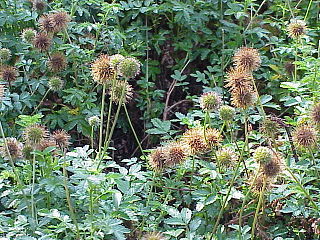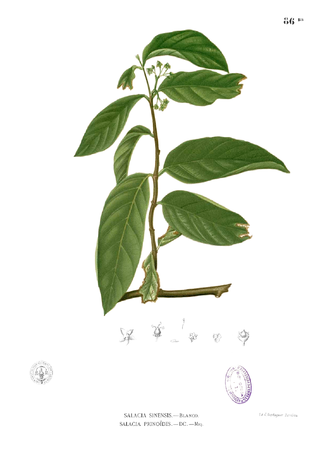
Acanthaceae is a family of dicotyledonous flowering plants containing almost 250 genera and about 2500 species. Most are tropical herbs, shrubs, or twining vines; some are epiphytes. Only a few species are distributed in temperate regions. The four main centres of distribution are Indonesia and Malaysia, Africa, Brazil, and Central America. Representatives of the family can be found in nearly every habitat, including dense or open forests, scrublands, wet fields and valleys, sea coast and marine areas, swamps, and mangrove forests.

Iochroma is a genus of about 34 species of shrubs and small trees belonging to the nightshade family Solanaceae. Species are native from Mexico to south Brazil. They are found in the forests of Mexico and South America. Their hummingbird-pollinated flowers are tubular or trumpet-shaped, and may be blue, purple, red, yellow, or white, becoming pulpy berries. The cupular (cup-shaped) calyx is inflated in some species. The leaves are alternate, simple, and entire.

Cyphomandra was a formerly accepted genus in the plant family Solanaceae. It used to contain about 35 species native to the Americas from Mexico southwards to Northern Argentina.

Discaria is a genus of 6 species of flowering plants in the family Rhamnaceae, native to temperate regions of the Southern Hemisphere, in Australia, New Zealand and South America.

Acaena is a genus of about 60 species of mainly evergreen, creeping herbaceous perennial plants and subshrubs in the family Rosaceae, native mainly to the Southern Hemisphere, notably New Zealand, Australia and South America, but with a few species extending into the Northern Hemisphere, north to Hawaii and California.

Muehlenbeckia or maidenhair is a genus of flowering plants in the family Polygonaceae. It is native to the borders of the Pacific, including South and North America, Papua New Guinea and Australasia. It has been introduced elsewhere, including Europe. Species vary in their growth habits, many being vines or shrubs. In some environments, rampant species can become weedy and difficult to eradicate.

Parkia is a genus of flowering plants in the family Fabaceae. It belongs to the mimosoid clade of the subfamily Caesalpinioideae. Several species are known as African locust bean.

Haplopappus is a genus of flowering plants in the family Asteraceae found in South America, mostly restricted to the dry regions of the Southern Andes, Chilean Matorral, and Patagonia.

Tournefortia, commonly known as soldierbush, is a genus of flowering plants in the borage family, Boraginaceae.

Salacia is a genus of plants in the family Celastraceae. They are woody climbers naturally found in tropical regions.

Jaltomata is a genus of plants in the family Solanaceae. According to molecular phylogenies, Jaltomata is the sister genus to Solanum, which includes tomato, potato, and eggplant. Jaltomata has a neotropical distribution, in that species occur from the United States southwest through Latin America, and into the Andean region of South America. Species encompass a wide range of vegetative and reproductive trait variation, including growth habit, floral size, shape and color, as well as fruit size and color. The fruits of some of the species are eaten by humans in Latin and South America. Depending on the species, fruits may be red, green, orange, or dark purple.

Phlogacanthus is a genus of flowering plants in the family Acanthaceae and tribe Andrographideae. Its distribution includes India through to Indo-China, southern China and Sulawesi.
Orbivestus is a genus of shrubs in the family Asteraceae, native to tropical Africa, the Arabian Peninsula and the Indian subcontinent. Its species were formerly placed in the genus Vernonia.
Culcitium is a genus of flowering plants belonging to the family Asteraceae.
Saracha is a genus of flowering plants belonging to the family Solanaceae. It is in the Solanoideae subfamily.
Neuontobotrys is a genus of flowering plants belonging to the family Brassicaceae.
Oschatzia is a genus of flowering plants belonging to the family Apiaceae. It is also in the subfamily of Azorelloideae.
Peltostigma is a genus of flowering plants belonging to the family Rutaceae.
Zanthoxyloideae is a subfamily of the family Rutaceae.












